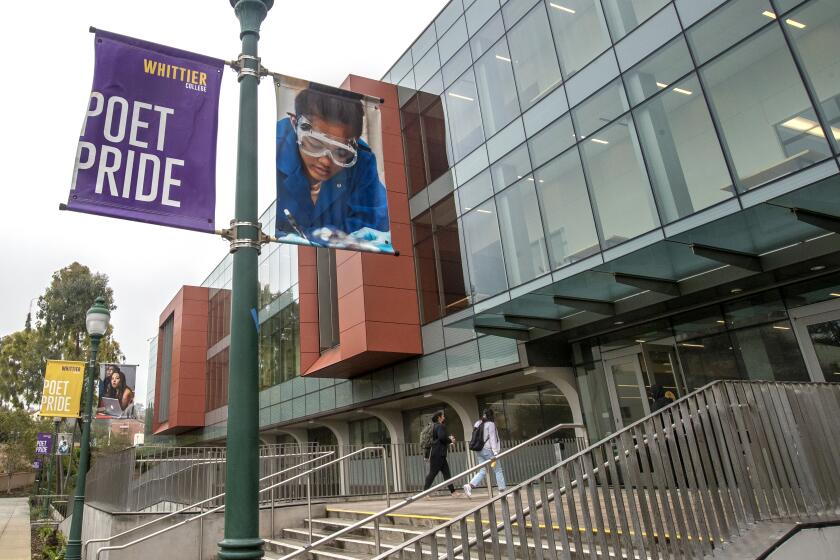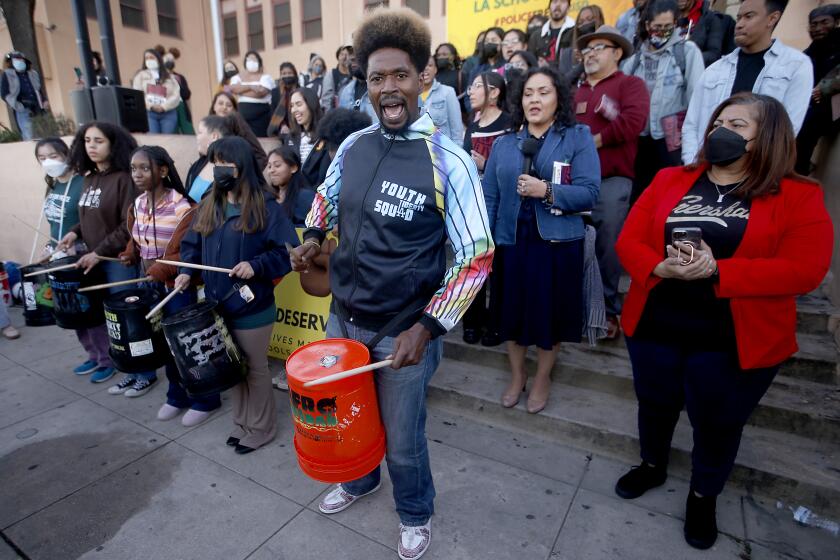Hidden expulsions? Schools are removing students, but vague data can mask the reason
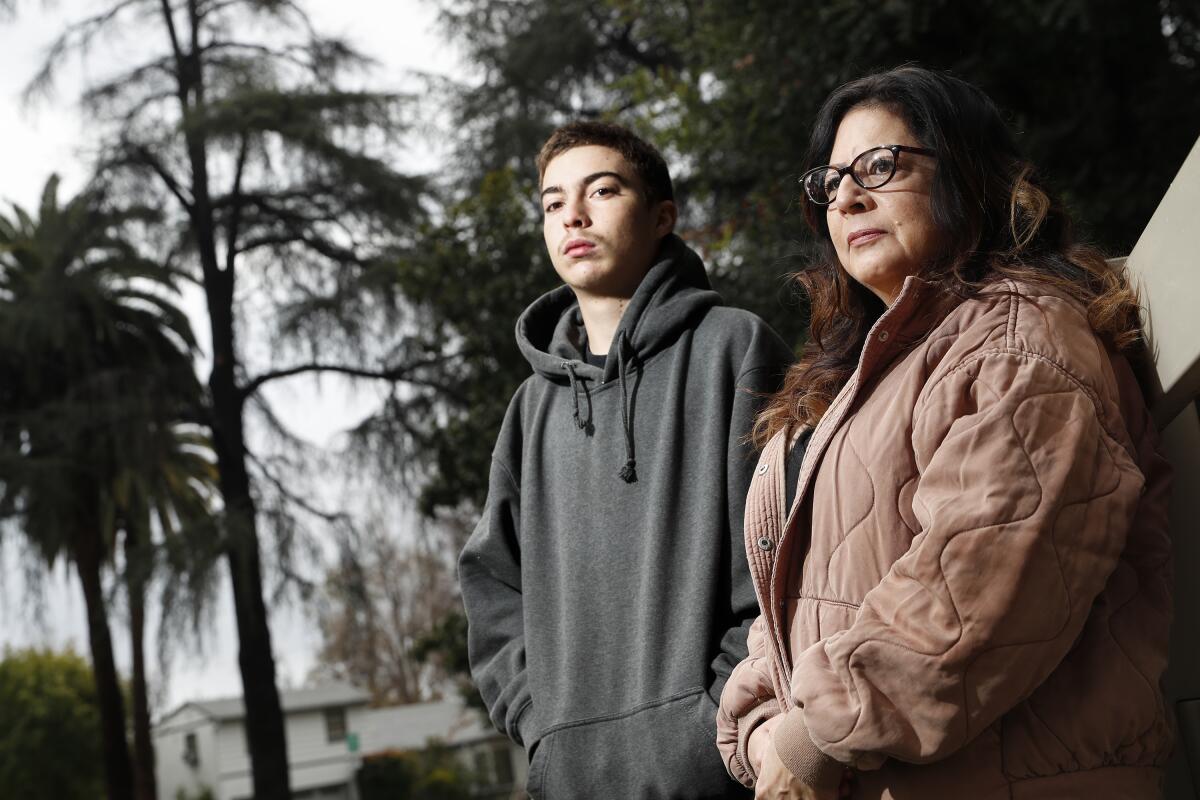
- Share via
Twice a week, Ricky Carmona, 16, leaves his La Verne home to attend school in makeshift classrooms a few doors down from the Boot Barn at a nearby strip mall.
He ended up at Options for Youth charter school in Upland after he was suspended from Bonita High at the start of the 2022-23 school year for vaping in the bathroom. Less than a week after the suspension, Stephanie Carmona, his aunt and guardian, received a letter: The principal had recommended Ricky for an “involuntary transfer” out of Bonita.
Ricky wasn’t technically being expelled. But to him, it sure felt like it.
“A transfer is, like, something you do voluntarily,” he said.
Transfers like Ricky’s represent a large yet hidden share of California’s exclusionary discipline, blocking students from attending their schools and pushing them onto new campuses or into smaller, alternative schools, according to an investigation by the Hechinger Report, a nonprofit education newsroom.
While some educators defend transfers as a gentler alternative to expulsion, critics say these moves have limited or no due process protections and can carry the same problems associated with expulsion by disrupting a child’s education.
Despite policies that require California school districts to report the number of students transferred, the state Department of Education’s overlapping and vague reporting requirements mean it’s often unclear why a student changed schools.
California officials declined to provide statewide data about transfers, saying a database in which they maintain the information is exempt from disclosure because it contains identifying information about students.
A Hechinger analysis of district-level reports — obtained through public records requests to 23 of the state’s largest districts — revealed deeper insights into local transfer practices that take place with little public accountability or clear disclosure.
Over five academic years, from 2016-17 to 2020-21, these districts recorded 5,800 transfers for “specific discipline reasons.” As many as 3,700 of these might have been expulsions.
School districts are required to report expulsions to the state and to the public. But the “specific discipline reasons” category also includes involuntary transfers such as Ricky’s and court-mandated transfers to schools at juvenile justice facilities.
The districts — which serve almost 1 million, or about 17%, of the state’s 5.9 million students — also recorded more than 16,300 transfers to alternative schools, another category. Student advocates and educators say these moves frequently follow behavioral problems. But the state does not require districts to specify the reason a student is transferred to an alternative school.
Students can enroll in alternative schools to meet their needs: smaller campuses, behavioral or academic support or a more flexible school day. Educators and others say it can be beneficial for some students to change schools and get a fresh start.
But advocates say transparency is needed in state data to ensure that districts are not hiding disciplinary transfers to alternative schools, especially when those campuses can have lower academic rigor and graduation rates and higher chronic absenteeism.
“Transfers are being used as a backdoor way of removing kids from school,” said Chelsea Helena, an education attorney for Neighborhood Legal Services of Los Angeles County. “And it’s impacting Black and brown kids more.”
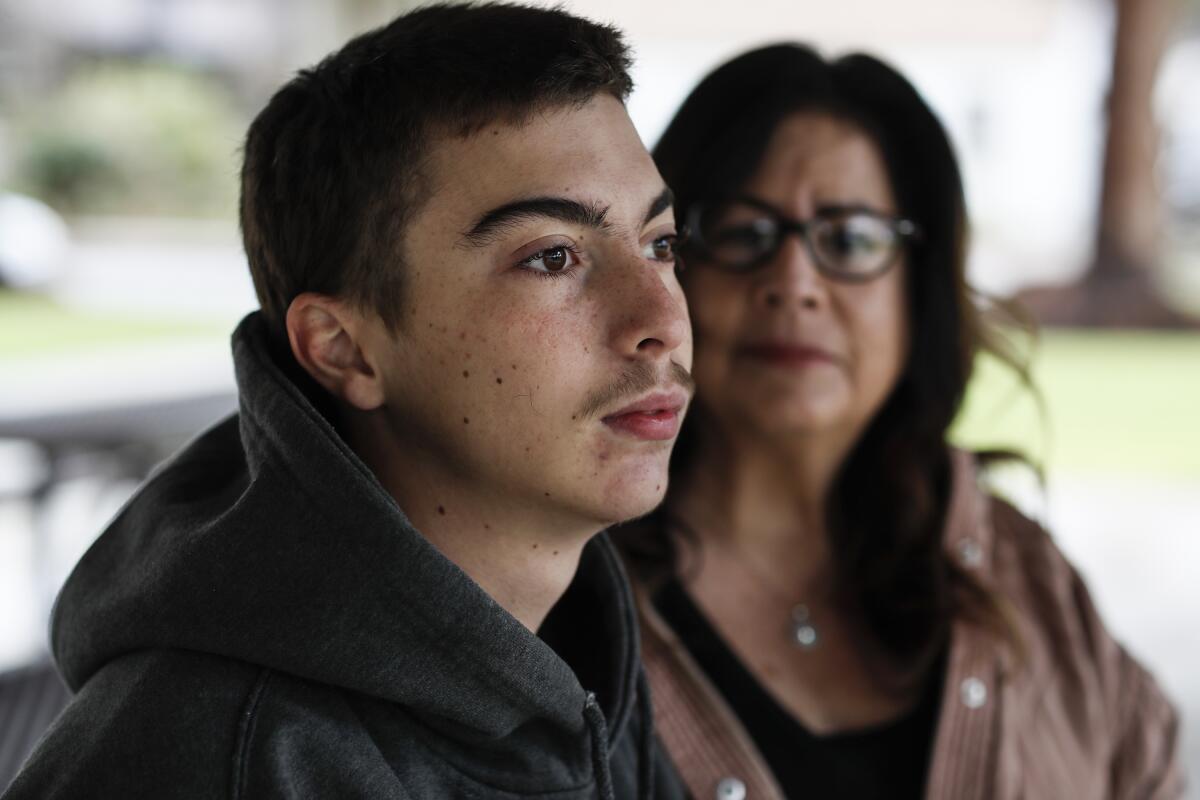
In the majority of districts, including San Bernardino City Unified, Long Beach Unified and Oakland Unified, Black students were disproportionately represented among students transferred for disciplinary reasons or to alternative schools, according to the district data. While Latino students were not overrepresented in most districts, their sizable share of enrollment means they were most frequently transferred.
Even more disciplinary transfers probably occur when students are counseled to voluntarily switch from one traditional school to another. Victor Leung, director of education equity for the ACLU of Southern California, says these types of transfers are “one of the most common and insidious problems” his team sees. Parents are often pressured to agree to a voluntary transfer to avoid a formal expulsion, even though the expulsion carries due process and appeals rights, Leung said. An additional layer of oversight requires school board approval of expulsions.
Unlike expulsions — generally assigned for causing serious physical injury or possessing drugs or weapons — transfers are largely unregulated. Districts develop their own policies on transfers, with varying — if any — rules about appeals.
In 2014, a state law prohibited districts from forcing students to transfer if they were recommended for expulsion but won their expulsion hearing. Yet a loophole remains that allows districts to transfer students instead of expelling them and face minimal scrutiny.
Following a reporter’s inquiries to the Department of Education about its transfer process oversight and reporting rules, state Supt. Tony Thurmond in a news release acknowledged “that some districts have pushed families toward voluntary or involuntary transfer to avoid reporting expulsions.”
Last month he announced the creation of a public tip line to identify districts doing exactly this.
“School districts trying to hide actual discipline rates through practices such as masking expulsions as transfers will not be tolerated,” Thurmond said.
How transfers can hurt kids
One reason expulsions have come under attack in California and nationwide is because of the disruption they cause in students’ lives and academic trajectories. California has one of the lowest expulsion rates in the country.
Switching schools, whatever the reason, tends to be bad for kids, harming their development, disrupting their relationships and, most severely and consistently, suppressing their test scores and likelihood of graduation.
In Ricky’s case, he is further behind at Options for Youth and is barely accumulating credits. He spent more than half the school year completing packets mostly independently — and the family is exploring a GED diploma as an alternative goal.
One of California’s oldest liberal arts colleges, and the alma mater of President Nixon, faces turmoil as some critics question its viability.
Neither the Bonita Unified School District nor Options for Youth commented on his situation.
“Any disruption to a child’s education program is a problem,” said Helena, of Neighborhood Legal Services. “Especially coming off of two years of catastrophic disruption to kids’ education.”
In the 23 districts that provided data, transfer numbers varied widely.
For example, the 114,500-student San Diego Unified, the second-largest district in the state, expelled 335 students, transferred 288 for specific discipline reasons and sent 94 to alternative schools.
But Sacramento City Unified, which serves nearly 44,000 students, expelled 52, transferred 511 for specific discipline reasons and logged 3,281 transfers to alternative schools.
Stephan Brown, director of student hearing and placement at Sacramento City Unified, said families often support transfers.
The majority of transfers to alternative schools in Sacramento City Unified are for reasons other than discipline, such as being behind on coursework, he said. The district has partnered with community organizations that help mediate conflicts and minimize the need for exclusionary discipline. Brown considers transfers to be a positive alternative to expulsion.
Administrators at Riverside Unified and San Bernardino City Unified also described their alternative schools as supportive, complementary educational options for students who have struggled in traditional schools.
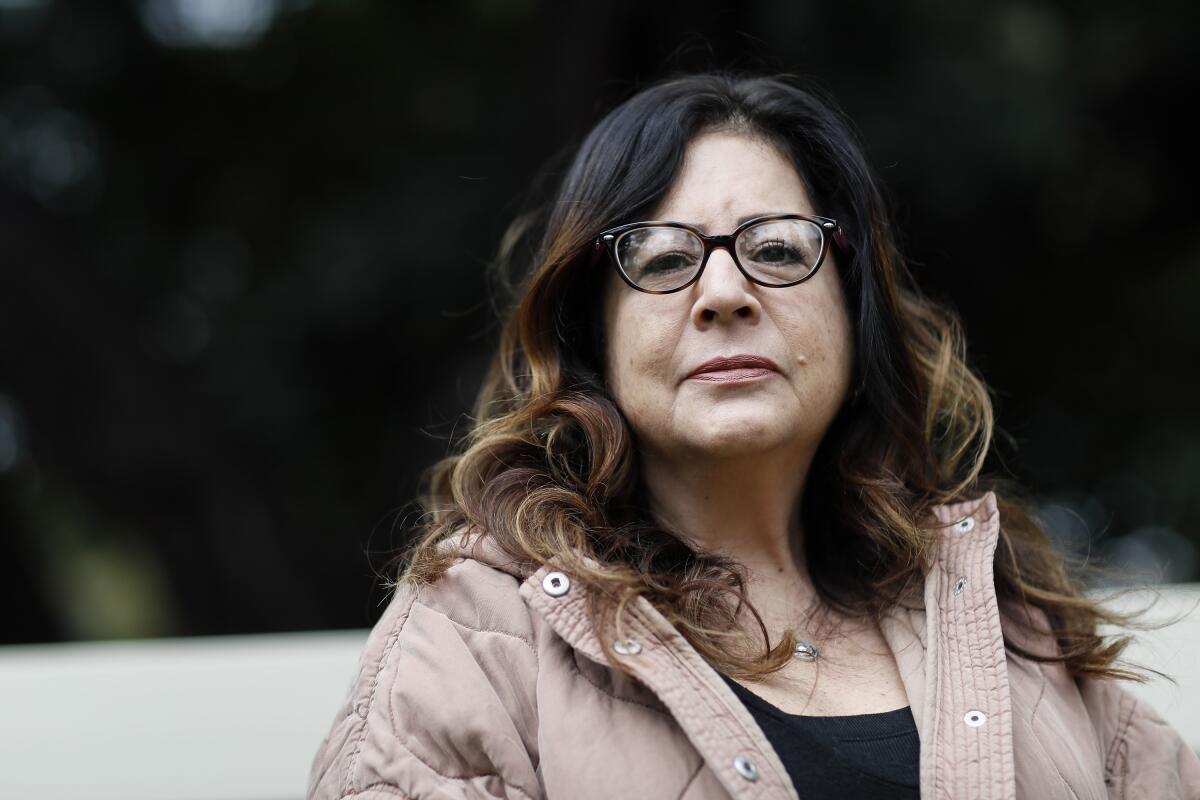
Los Angeles Unified has its own transfer category
Transfer data are unclear for Los Angeles Unified, which has spent years working to reduce exclusionary discipline. The district beat the state by almost a decade in banning suspensions for willful defiance, including for actions such as chewing gum, playing with a phone, tapping feet and napping.
Despite its discipline reform initiatives, the largest district does not appear to follow the state’s instructions for logging its transfers.
Activists challenge L.A. Unified superintendent’s support of school police, as well as school board members who reduced the police budget but did not disband the agency.
In data L.A. Unified submitted to the state, obtained through a public records request, the district reported zero transfers for disciplinary reasons and zero transfers to alternative schools in the academic years from 2016-17 to 2020-21.
The district operates a program it calls “opportunity transfers” for students who are moved to a new school “to address student misconduct after prior interventions have failed.” The district records such transfers internally.
A district spokesperson, in writing, described opportunity transfers as a response to less egregious student misbehavior that falls short of warranting expulsion. These transfers tend to be voluntary — proposed by the school or district but agreed upon by the student’s family. Parents can appeal the transfer, and the decision of the appeals committee is final.
L.A. Unified’s internal records show that it made 138 opportunity transfers from the 2017-18 school year through 2021-22.
The district logs opportunity transfers with the state as “regular, nondisciplinary transfers” because they are voluntary, the spokesperson said. But such a classification conflicts with the district’s own discipline-related definition and with state guidance.
L.A. Unified served almost 35,000 students across 53 of its alternative schools in 2021-22, according to state enrollment data. Officials did not answer questions about how transfers to alternative schools are recorded.
Disciplinary efforts have focused on expanding programs nurturing positive student behavior and improving school culture, including a daily focus on mindfulness and trauma-informed practices.
“We truly have an array of practices that are working to address school climate and positive culture in all schools,” said Pia Escudero, the district’s executive director of student health and human services.
Megan Stanton-Trehan, director of the Youth Justice Education Clinic at Loyola Law School, credits L.A. Unified for taking steps to reduce exclusionary discipline but questions the accuracy of the district’s reported transfer data.
Without a clear distinction between transfers that are discipline-related and those that are not, “it becomes difficult for the community to understand what the real problems are,” Stanton-Trehan said. “Is it really discipline? Is it attendance? Does the student need special education or other support that they’re not receiving?”
Lack of state oversight
In October 2021, Neighborhood Legal Services of Los Angeles County sued the California Department of Education, alleging that Black and Latino students are disproportionately harmed by some districts’ disciplinary policies and that the state has failed to monitor and take action against transfers that function as exclusionary discipline.
The state is violating the right of equal protection for students by failing to safeguard their right to an equal education, the suit alleges. Attorneys are preparing to go to trial.
There have been other calls for legislative action, including requiring clear public reporting of discipline-related transfers with categories that identify why a student transferred. State Sen. Nancy Skinner (D-Berkeley), who has introduced a series of measures on school discipline, said she is considering how the Legislature might take action after learning of the Hechinger Report’s findings.
The California Department of Education is working on guidance that would advise districts on their use of disciplinary transfers, a spokesperson said.
Recent momentum to address transfers comes as schools have reported more severe problems with student behavior since the pandemic.
Experts say districts must be proactive, which requires training teachers in child and adolescent development, relationship building and behavior management as well as staffing schools with adequate numbers of counselors and social workers.
Still, school leaders face what can seem like competing priorities: serving all students, including those who misbehave and require discipline, and maintaining an orderly environment. Advocates say understanding transfers is key to understanding how discipline is being meted out to California students.
When Ricky talks about his situation, he slips into saying he was expelled.
“It might as well be [an expulsion],” he said. “I can’t go back.”
This article was produced by the Hechinger Report, a nonprofit, independent news organization focused on inequality and innovation in education.
More to Read
Sign up for Essential California
The most important California stories and recommendations in your inbox every morning.
You may occasionally receive promotional content from the Los Angeles Times.
